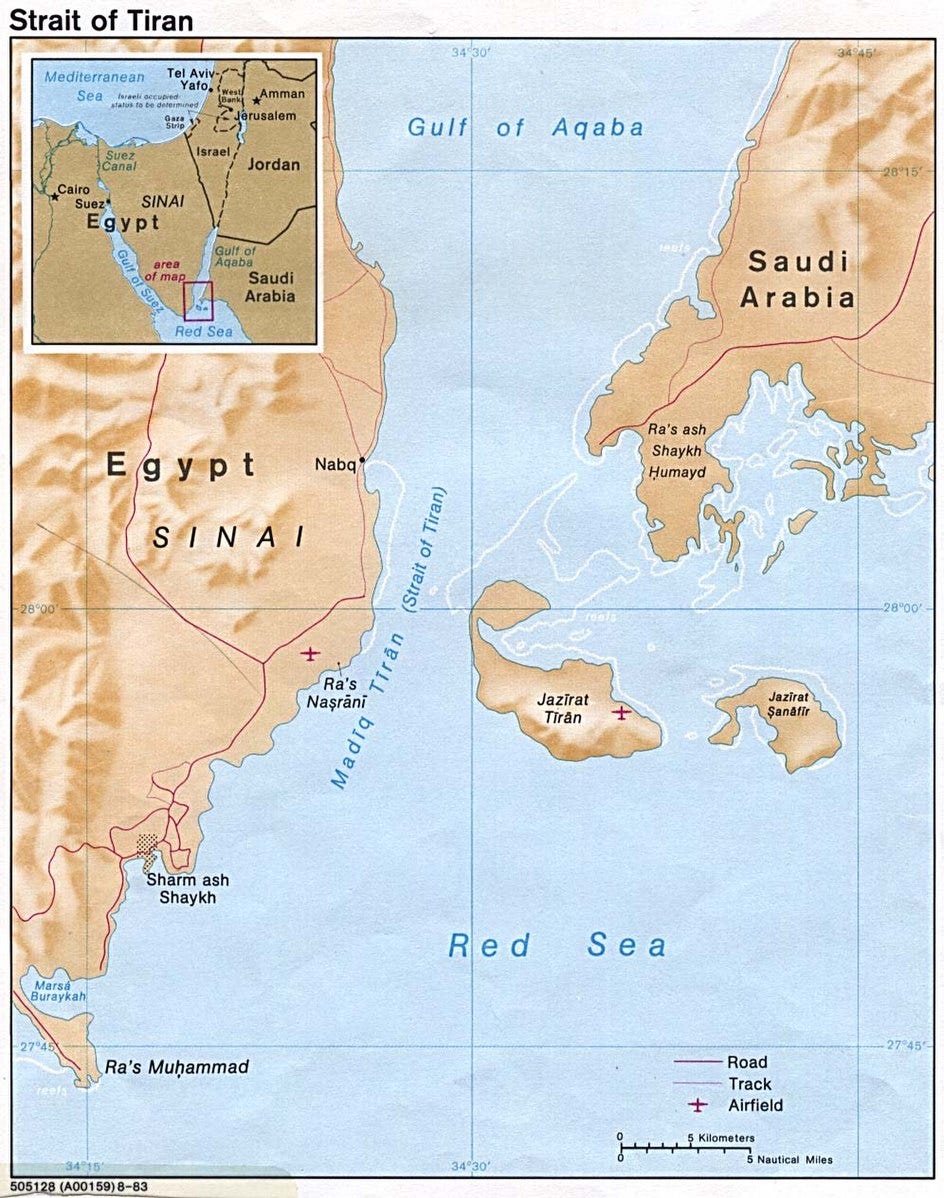Geographical Highlight: Sanafir and Tiran Islands
Red Sea Rising, Supplement 1, Lecture 1
(Credit: unknown, open source)
Summary:
Tiran and Sanafir – two small islands with signficant strategic value at the top of the Gulf of Aqaba in the Straits of Tiran, separating the Sinai Peninsula from the Eastern Coast of Saudi Arabia.
Israel considers freedom of passage through the Straits inviolable, as they are Israel (and Jordan’s) only access to the Red Sea.
The Straits (and islands) have been variously under Israeli, Egyptian, and multinatioal forces control from1948 to 2022, through Saudi always had the strongest claim.
After a politically fraught domestic political process, and a financial deal with Saudi Arabia, in 2017 Egypt consented to cede sovereignty over Tiran and Sanafir to Saudi Arabia.
Israel gave writen consent in 2022 to the transfer in Summer of 2022, after which Saudi Arabia added the two islands to its official maps.
Saudi Arabia has not formally taken possession of the Islands, and nor has Israel received formal Saudi guarantee of safe passage through the Straits (which is technically granted by the 1994 UN Convention on the Law of the Sea).
Related details, including overflight permission for Israeli airline traffic over Saudi Arabia were to be sorted in the context of a Saudi-Israeli normalization accord - which Iran intentionally disrupted last year with its support for Hamas’ 10/7 attack on Israel.
Saudi Arabia’s more recent interest in the islands is related to their value to the Saudi North-West regional ‘giga’ development project, known as NEOM.
Tiran and Sanafir sit atop of the Red Sea, within a thin waterway that separates the Sinai Peninsula from Saudi Arabia and provides Israel and Jordan access to the Red Sea, via the port and Eilat, and Aqaba, respectively. While scant in the news, the two islands have played a role in every major Arab Israeli conflict, due to their strategic position at the intersection of Israel, Jordan, Saudi Arabia and Egypt. For Israel, the islands have long represented a point of strategic and economic vulnerability. The islands, which have been uninhabited for much of the 20th century, are best controlled by whoever holds the Eastern shore of the Sinai Peninsula.
The Israeli War of Independence
Egypt closed the Suez Canal and the Straits of Tiran to Israeli shipping shortly after the 1948 Israeli War of Independence.
In 1950, Saudi Arabia ‘invited’ Egypt to take over temporary administration of Tiran, as Egypt was better positioned to defend Tiran from Israeli takeover. — due to the privileged Saudi relationship with the United States, whose relationship with Israel was based on different considerations, but equally privileged.
In private correspondence with the United States, Egypt tried to undermine Saudi claims to the islands, claiming a 1906 boundary agreement with the then-crumbling Ottoman Empire granted it ownership. When useful, Israel referenced a thriving Jewish kingdom on Tiran (then known as Yotvat) as late as the 5th century AD.
The Suez Crisis
In 1956, Egyptian leader Gamal Abdel Nasser nationalized the Suez Canal, in part to dissipate the political impact of America and Britain’s reneging on their offer to finance the Nile Aswan High Dam, a prestige effort that was to provide hydroelectric power, increase the amount of cultivatable land, and reduce the damage done by seasonal floods. The withdrawal was linked to Nasser’s growing ties with the US’ nemesis, the Soviet Union.
Nasser’s seizure of the canal precipitated the Suez Crisis, in which Britain and France sought to reopen the canal by force. France and the UK convinced Israel to invade the Sinai, creating a pretext for both countries to separate the combatants by force and re-establish control over the canal. Israel was less concerned with the Canal, as it was reopening the Straits. Israel occupied and held Tiran and Sanafir from 1956, until the American and Soviet pressure forced the French and the British, and then the Israelis to follow suit. Freedom of navigation through the Straits was enforced by the UN’s first armed peacekeeping mission, UNEF-1 positioned on the Eastern side of the Sinai, overlooking Tiran. By the end of the 50s Israel was importing most of its energy needs from the Shah’s Iran, through the port of Eilat.
The Straits became an issue once again in 1967. As rumors spread of Israeli intent to attack Syria, Nasser kicked out the U.N. force and once again closed the Straits of Tiran, triggering The Six Day War – a disaster for the Arab States that resulted in significant territorial losses for Jordan, Syria and Egypt, including the Sinai, Gaza, East Jerusalem, the Golan Heights and the West Bank. The Israelis held Sanafir and Tiran until 1973.
In that year, Arab States launched a surprise attack on Israel on Yom Kippur, the Jewish day of Atonement, leading to another closure of the Suez Canal to Israeli and Western shipping, and the Arab Oil Embargo, both lasting until 1975. Anwar Sadat succeeded Nasser in 1970 upon the latter’s death, and severed Egypt’s relationship with the Soviets in1972.
Sadat signed a landmark, formal peace treaty with Israel at Camp David in 1978. He was able to do this, despite widespread Egyptian hostility towards Israel, because the deal returned the Sinai to Egypt. A multinational force (MFO) was again positioned on the islands pursuant to the Camp David Accords in 1982, to assure freedom of navigation.
By the terms of the Camp David Accords, any change in “ownership” or control of the islands needed to be ratified by both Egypt, and Israel, considering established assurances of freedom of navigation. This status quo remained until 2010, when the Saudis took initial steps to reclaim the Islands. This would have an impact on both Saudi Arabia’s economic aspirations in the Northern Red Sea, and the prospects for any future Saudi Israeli peace, which became more plausible after the Abraham Accords of 2020 which resulted in a normalization agreement between Israel and the United Arab Emirates.


